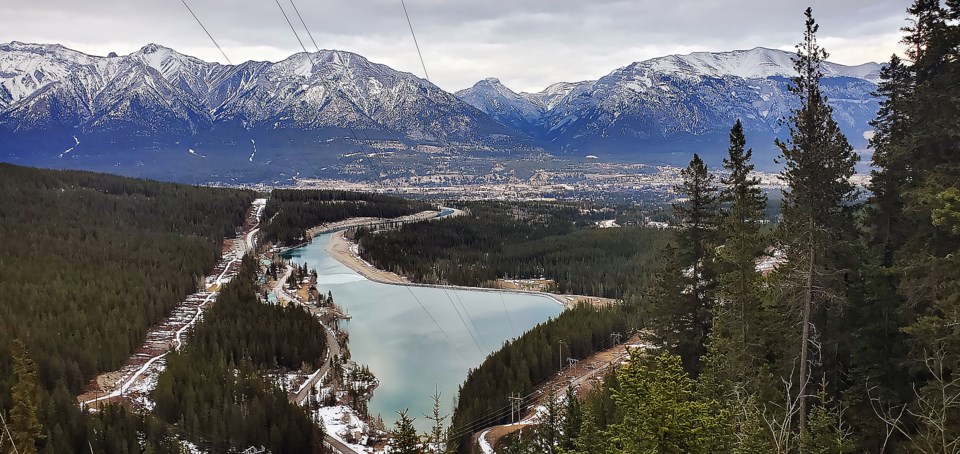CANMORE – A series of pipe leaks, above average temperatures and less than normal rain in Canmore are contributing factors for Epcor’s mandatory non-essential advisory for Canmore, Dead Man’s Flats and Harvie Heights.
In addition, Epcor is investigating the cause of a “large, unexpected overnight demand” in water use that is not related to tourists staying in town as another contributing factor to the water restrictions, which have now been extended until further notice.
At least five pipe leaks have been detected since a new leak detection technology began running in Canmore in mid-May. Since its launch, four leaks have been found and a fifth was discovered Monday (June 12).
The information comes days after Epcor asked all residents of the three population centres to halt non-essential water use until at least Monday “due to hot temperatures and an increase in demand.”
“Over the weekend, through a combination of community demand management, system operations and system leak repairs, the Grassi reservoir was refilled to required operating levels,” a media release stated.
Epcor is continuing to assess the reservoir levels and the mandatory non-essential water restrictions continue.
“Over the past several weeks, Epcor has seen large, unexpected overnight demand,” the release stated. “This demand is unrelated to population growth or visitor trends, which have been anticipated through system design and operations. We continue to look for the cause of the unusual demand.”
Laura Ehrkamp, a specialist in external communications for Epcor, said three have since been repaired, but since material leaks are completed visually and it was difficult to tell how long the leaks had been occurring.
When leaks take place in Canmore’s water system, repair work is typically done in the fall when groundwater levels are lower and before winter frost impacts the ground.
“We are repairing the leaks in locations where we can remove groundwater and ensure the safety of the workers involved,” she said.
On Monday, Epcor announced the Peaks of Grassi reservoir had returned to the 60 per cent rate, but the non-essential water ban would continue for Canmore Dead Man’s Flats and the commercial area of Harvie Heights.
In a media release, the Town of Canmore emphasized tap water remains safe to drink.
The Grassi reservoir is an underground tank that is not visible to the public. It is often confused with the water bodies that make up the Rundle Forebay part of the drinking water system.
As part of the ongoing water restrictions, personal essential use is exempt from the ban, and includes health, safety, and hygiene needs for laundry and washing. The company and municipality say personal essential use should ideally occur from 8 a.m. to 5 p.m., avoiding evening and overnight water use where possible.
“Please be mindful of your water consumption and maximize water efficiency wherever possible,” the Epcor release stated.
The restriction asks people to restrict watering lawns, gardens, trees and shrubs as well as washing sidewalks, driveways or houses.
The restriction also doesn't apply to businesses that need water for income and livelihood purposes, such as car washes, laundromats and hotel laundry operations. The ban also doesn’t apply to golf courses that aren’t on Canmore’s distribution system to irrigate property.
However, though the advisory was for all three locations, the Grassi reservoir only supplies water to the west and central areas of Canmore. It has a supply of 5,000 cubic metres in volume and its facility is pumphouse No. 2.
Ehrkamp said “the entire community ban was needed to manage demand and allow Grassi reservoir to refill.”
The recently completed Utility Master Plan (UMP), which is traditionally approved by council but not done so this time, stated potable storage reservoirs in Canmore have storage of 18,966 cubic metres in volume.
Other Canmore reservoirs are Benchlands with 7,300 cubic metres for east and central Canmore, Silvertip with 5,400 cubic metres for the east area and the two pumphouses having a small volume totalling 1,266 cubic metres.
The Town’s main sources of water are two deep wells supplying groundwater to Pumphouse No. 1 and surface water from Rundle Forebay that supplies Pumphouse No. 2.
After the water is treated, it is stored in five reservoirs and five pump stations, which in turn are distributed to three supply areas that are western, central and eastern.
The UMP also stated the Benchlands reservoir was reported to have a storage volume of 11,200 cubic metres, but a review of the design “indicated the total active volume of the reservoir is calculated to be 7,300 m3.”
From 2018-21, there was an average water distribution of 2.67 million cubic metres and a consumption rate of 1.84 million cubic metres for a loss factor of 1.45. The loss factor, according to the UMP, is system losses, fire hydrant operations and unmetered water connections.
The UMP highlights “in total, approximately 30 per cent of the water distributed in Canmore is unmetered.”
The bulk of the Town’s water pipes – about 64 per cent – are 30 years or less. The UMP stated about 65 per cent of water mains are PVC and 30 per cent ductile iron, with the average age of water lines being about 30 years old. There are 118 kilometres of pipe, according to the UMP.
The organization previously threatened that anyone not following the measures would lead to being informed and potentially “water service could be disconnected.”




